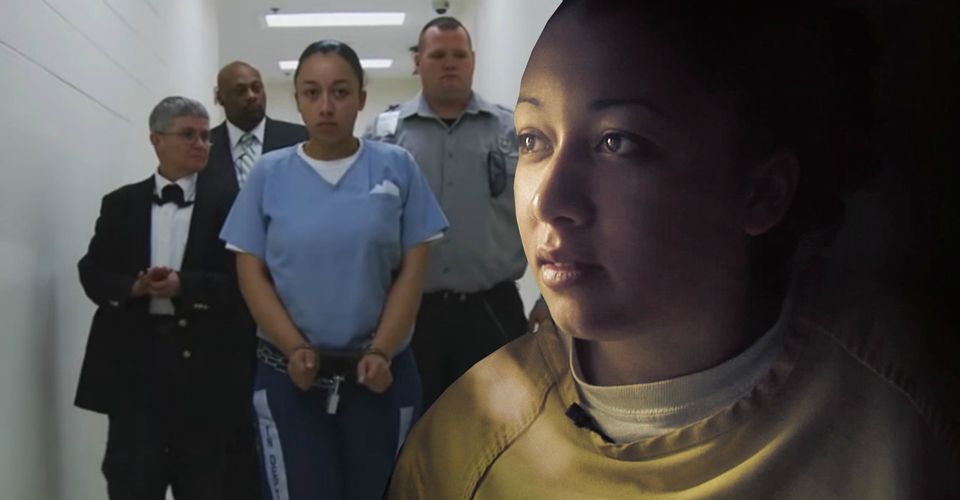Murder To Mercy True Story: What Cyntoia Brown’s Documentary Leaves Out

The latest Netflix true crime documentary, Murder To Mercy: The Cyntoia Brown Story, has brought its own brand of controversy for what it leaves out of the true story. The documentary follows Cyntoia Brown-Long (Brown-Long is her married name; at the time of the trial she was just Brown) and her horrifying road from a sex-trafficked teenager convicted of murder, to her life as a grown woman freed from prison.
Brown-Long was convicted of killing Johnny Michael Allen, a 43-year old real estate agent from Nashville. In 2004, Allen agreed to pay her $150 for sex and took her to his house where she shot him in what she insisted was self-defense. She then told police she was forced into prostitution by a man called “Kut-Throat”, but prosecutors saw a different story and she was found guilty of first-degree murder, felony murder, and aggravated robbery. Although a minor, she was sentenced as an adult to life in prison, before being granted clemency from then Tennessee governor Bill Haslam after serving 15 years.
Murder to Mercy as a whole documentary feels very rushed, as important characters and events seem to be glossed over, or just down right missed. Recently, Netflix released many new true crime documentary series, including Tiger King and The Trials of Gabriel Fernandez, which attracted fans due to ever-evolving storylines where key figures and events could be fleshed out over a number of episodes. Murder To Mercy seemed like a missed opportunity for Netflix to continue their successful true crime streak. Here are some important details about the case, Brown-Long’s life, and the overall scope of what this meant for the criminal justice system that Murder To Mercy left out.
The Truth of Garion “Kut-Throat” McGlothen

Garion “Kut-Throat” McGlothen was Brown-Long’s pimp, who she said would regularly sexually and physically abuse her. Brown-Long claimed McGlothen was the one who forced her into prostitution, and on the night of killing, forced her to solicit sex, thus leading to the encounter with Allen. The documentary glosses over the overall involvement of McGlothen and briefly shows a young Brown-Long describing her relationship to him in a court hearing. Prosecutors refuted her story of self-defense, arguing instead that Brown-Long killed Allen in order to rob him, money that would ultimately go to McGlothen. In March 2005, McGlothen was shot and killed by a man named Quartez Hines in what was described as a gang-related drug deal.
Although Murder To Mercy’s main focus was the case of Brown-Long, McGlothen’s role in her life is impossible to overlook. Not only did she live with him and work for him, but the physical and psychological abuse she suffered under him is impossible to ignore. Even on the night she was arrested, she insisted to officers that McGlothen had nothing to do with the killing, showing just how strong of a hold he truly had over her. Netflix documentary Murder To Mercy failed to mention any of the relationship between Brown-Long and McGlothen, an important backstory to provide context for the early life of Brown-Long and the severe mental and physical pain she endured under him.
Who Was Johnny Michael Allen?

Murder To Mercy on Netflix had the chance to open the dialogue surrounding who Johnny Michael Allen was. Allen, a 43-year-old real estate agent, was shot and killed by Brown-Long because she claimed she feared for her life after she became uncomfortable in his home. The two met outside an East Nashville Sonic restaurant where Brown-Long said he offered her money in exchange for sex. In her police testimony, Brown-Long said Allen told her of his military experience and showed her some rifles that he owned. She became uneasy with the situation and went to bed where he proceeded to get naked and tried to touch her. Throughout the night she became increasingly paranoid and when he reached over towards the bedside table, she pulled out a .40 caliber pistol that McGlothen gave her and shot Allen in the back of the head, thinking he was reaching for his own gun.
Many of Allen’s friends and family refused to accept this story and saw a different version; that Brown-Long was there to kill and rob a good Samaritan who was only trying to help. Brown-Long’s defense sought to tarnish Allen’s reputation and called two witnesses to testify on behalf of Brown-Long. One was a 17-year-old waitress at a restaurant where Allen frequented. She claimed that waitresses would fight over who would serve him because he made all of them uncomfortable. The judge ruled her testimony irrelevant. The second woman claimed Allen raped her after he invited her home instead of their initial plans of going to a movie. These two conflicting sides of Johnny Allen should have been explored in Murder To Mercy, but instead, Allen becomes a brief passenger as simply the victim of a terrible crime.
The “White” Narrative and The Issue of Race

Many complaints surrounding Murder To Mercy is the role of the “white” narrative throughout the Netflix film. Although it is hard to ignore and given the circumstances of the case, for a Netflix true crime documentary to seek the utmost accuracy, this one lacks that sentiment. At the time, news outlets saw the narrative as a criminal black woman killing a wealthy white professional. But what Murder To Mercy fails to note is the true relationship between Brown-Long and her adoptive mother Ellenette Brown. Facts of Brown-Long’s life come out in spurts, and what viewers learn is very much important.
Her biological mother, Georgina Mitchell, drank through her pregnancy, which may have left her daughter with fetal alcohol syndrome, something experts for the defense said would have affected Brown-Long’s decision-making abilities. She was adopted as a young child by Ellenette, who provided her with a loving home. But the Netflix film really only showed her adolescent life as one in shambles; running away, using drugs and alcohol, and making poor decisions, thus leaving out that she did in fact have someone who sought nothing but the best for her. In regards to Ellenette, who stuck by her side through everything, the film never truly dives into their relationship and only shows Ellenette’s true motherly love on a surface level.
Murder To Mercy never explained if race was a motive for Brown-Long’s treatment as an adult, despite her being a teenager at the time of her sentencing. What Murder To Mercy does is seemingly create a divide in the narrative of how the film is told. Much of the film includes the laundry list of troubles she and her community faced, unfiltered interviews on dilapidated porches, and the cast-off of that old life on full display, mirrored with white doctors, prosecutors, and defense attorneys somewhat criticizing her upbringing. The documentary has a purpose and a mission to accurately portray the setting as they wish in order to provide viewers the opportunity to see the reality of the situation, but director Daniel Birman mostly ignores the racial politics of the case and fails to question the influence race had in trying and convicting Brown-Long as an adult, or at all.
The Fight To Free Cyntoia

Much of Murder To Mercy is centered around Brown-Long’s potential to rehabilitate after the entire 15-year ordeal. Interviews with Brown-Long’s biological mother and grandmother offer insight into their own horrifying experiences of sexual abuse, drug abuse and mental illness, something obviously not lost on Brown-Long herself. Footage of Brown-Long working diligently in prison to get an education in order to educate herself on her own circumstances, as well as those of others who have fallen victim to similar ones, tend to be front and center along with her journey inside jail. Much of the film focuses on the self; how an individual works to repair oneself in order to succeed in the end. This is not lost on viewers, for that sentiment is beyond important for the growth of Brown-Long, but barely any time is spent on the grueling operation to free her.
The public may remember the #FreeCyntoiaBrown movement after the rise of the #MeToo movement, but the in-depth justice reform and the mission to free Brown-Long was lost in the more personal narrative surrounding Murder To Mercy. There is a brief mention of celebrities leveraging their influence to spark the debate that would eventually lead to her appeal for clemency, but that’s all it was; a brief mention. Something that could been explained over the course of an hour seemed to last one minute, adding to the list of missed opportunities for Murder To Mercy. The very title of the documentary hints that a journey took place, so just how Brown-Long got from a convicted murderer to a free woman seeking mercy should have been explored further.
Brown-Long Had Nothing To Do With The Documentary

In 2011, PBS aired a documentary film Me Facing Life: Cyntoia’s Story, directed and produced by Murder To Mercy director Daniel Birman. Much of the same footage appears in both documentaries because Birman sold Murder To Mercy to Netflix without Brown-Long’s knowledge and repurposed huge swaths of Me Facing Life for Murder To Mercy. Brown-Long was released in 2019 and all of this happened while she was incarcerated and without her consent.
In a since deleted Twitter post, Brown-Long wrote, “While I was still incarcerated, a producer who has old footage of me made a deal with Netflix for an UNAUTHORIZED documentary…My husband and I were as surprised as everyone else when we first heard the news because we did not participate in any way.” This seems troubling that her entire life story was being compiled, edited, and thoroughly investigated without her consent, let alone knowledge. The speculation of old footage and interviews, although well documented, has an air of inaccuracy without her candid input in Murder to Mercy. In that since deleted tweet, she added, “However, I am currently in the process of sharing my story, in the right way, in full detail, and in a way that depicts and respects the woman I am today. While I pray that the film highlights things wrong in our justice system, I had nothing to do with this documentary.” She has since released her memoir, Free Cyntoia: Search For Redemption in the American Prison System, and has become a public advocate for other women and girls trapped in the same system that punished her eighteen years ago.
About The Author

















